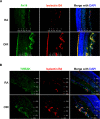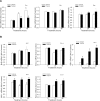TWEAK/Fn14 pathway is a novel mediator of retinal neovascularization
- PMID: 24408972
- PMCID: PMC3920863
- DOI: 10.1167/iovs.13-12812
TWEAK/Fn14 pathway is a novel mediator of retinal neovascularization
Abstract
Purpose: Retinal neovascularization (NV) is a major cause of vision loss in ischemia-induced retinopathy. Tumor necrosis factor (TNF)-like weak inducer of apoptosis (TWEAK) and its receptor, fibroblast growth factor inducible-14 (Fn14), have been implicated in angiogenesis, but their role in retinal diseases is unknown. The goal of this study was to investigate the role of TWEAK/Fn14 pathway in retinal NV.
Methods: Studies were performed in a mouse model of oxygen-induced retinopathy (OIR) and in primary human retinal microvascular endothelial cells (HRMECs). Hyperoxia treatment was initiated on postnatal day (P)14. Immunohistochemistry and quantitative PCR (qPCR) were used to assess retinal vascular changes in relation to expression of Fn14 and TWEAK.
Results: Fibroblast growth factor-inducible 14 mRNA was prominently increased from P13 to P17 in OIR retinas, whereas TWEAK level was slightly decreased. These alterations were normalized by hyperoxia treatment and were more striking in isolated retinal vessels. There was a discernible shift in the immunoreactivity of Fn14 and TWEAK from the neuronal layers in the healthy retina to the neovascular tufts in that of OIR. Blockade of TWEAK/Fn14 significantly prevented retinal NV while slightly accelerated revascularization. In contrast, activation of Fn14 positively regulated survival pathways in the B-cell lymphoma-2 (Bcl2) family and robustly enhanced HRMEC survival. Furthermore, gene analysis revealed the regulatory region of Fn14 gene contains several conserved hypoxia inducible factor (HIF)-1α binding sites. Overexpression of HIF-1α prominently induced Fn14 expression in HRMECs.
Conclusions: We found that the TNF-like weak inducer of apoptosis (TWEAK)/fibroblast growth factor inducible-14 (Fn14) pathway is involved in the development of pathologic retinal neovascularization. Hypoxia inducible factor-1α is likely implicated in the upregulation of Fn14.
Keywords: Fn14; TWEAK; ischemia-induced retinopathy; neovascularization; retina.
Figures











Similar articles
-
Blocking TWEAK-Fn14 interaction inhibits hematopoietic stem cell transplantation-induced intestinal cell death and reduces GVHD.Blood. 2015 Jul 23;126(4):437-44. doi: 10.1182/blood-2015-01-620583. Epub 2015 May 26. Blood. 2015. PMID: 26012567 Free PMC article.
-
The cytokine tumor necrosis factor-like weak inducer of apoptosis and its receptor fibroblast growth factor-inducible 14 have a neuroprotective effect in the central nervous system.J Neuroinflammation. 2012 Mar 6;9:45. doi: 10.1186/1742-2094-9-45. J Neuroinflammation. 2012. PMID: 22394384 Free PMC article.
-
Tumor necrosis factor-like weak inducer of apoptosis and fibroblast growth factor-inducible 14 mediate cerebral ischemia-induced poly(ADP-ribose) polymerase-1 activation and neuronal death.Neuroscience. 2010 Dec 29;171(4):1256-64. doi: 10.1016/j.neuroscience.2010.10.029. Epub 2010 Oct 16. Neuroscience. 2010. PMID: 20955770 Free PMC article.
-
The TWEAK-Fn14 pathway: a potent regulator of skeletal muscle biology in health and disease.Cytokine Growth Factor Rev. 2014 Apr;25(2):215-25. doi: 10.1016/j.cytogfr.2013.12.004. Epub 2013 Dec 24. Cytokine Growth Factor Rev. 2014. PMID: 24444596 Free PMC article. Review.
-
The TWEAK receptor Fn14 is a potential cell surface portal for targeted delivery of glioblastoma therapeutics.Oncogene. 2016 Apr 28;35(17):2145-55. doi: 10.1038/onc.2015.310. Epub 2015 Aug 24. Oncogene. 2016. PMID: 26300004 Free PMC article. Review.
Cited by
-
Inflammation and Neurodegeneration in Glaucoma: Isolated Eye Disease or a Part of a Systemic Disorder? - Serum Proteomic Analysis.J Inflamm Res. 2024 Feb 13;17:1021-1037. doi: 10.2147/JIR.S434989. eCollection 2024. J Inflamm Res. 2024. PMID: 38370463 Free PMC article.
-
Endoplasmic reticulum stress-regulated CXCR3 pathway mediates inflammation and neuronal injury in acute glaucoma.Cell Death Dis. 2015 Oct 8;6(10):e1900. doi: 10.1038/cddis.2015.281. Cell Death Dis. 2015. PMID: 26448323 Free PMC article.
-
Intravitreal anti-VEGF agents and cardiovascular risk.Intern Emerg Med. 2020 Mar;15(2):199-210. doi: 10.1007/s11739-019-02253-7. Epub 2019 Dec 17. Intern Emerg Med. 2020. PMID: 31848994 Review.
-
PERK Inhibition Suppresses Neovascularization and Protects Neurons During Ischemia-Induced Retinopathy.Invest Ophthalmol Vis Sci. 2023 Aug 1;64(11):17. doi: 10.1167/iovs.64.11.17. Invest Ophthalmol Vis Sci. 2023. PMID: 37566408 Free PMC article.
-
Survivin contributes to the progression of diabetic retinopathy through HIF-1α pathway.Int J Clin Exp Pathol. 2015 Aug 1;8(8):9161-7. eCollection 2015. Int J Clin Exp Pathol. 2015. PMID: 26464661 Free PMC article.
References
-
- Multicenter trial of cryotherapy for retinopathy of prematurity 3 1/2-year outcome–structure and function. Cryotherapy for Retinopathy of Prematurity Cooperative Group. Arch Ophthalmol. 1993; 111: 339–344 - PubMed
-
- Phelps DL. Retinopathy of prematurity. Pediatr Rev. 1995; 16: 50–56 - PubMed
-
- Tsilimbaris MK, Kontadakis GA, Tsika C, Papageorgiou D, Charoniti M. Effect of panretinal photocoagulation treatment on vision-related quality of life of patients with proliferative diabetic retinopathy. Retina. 2013; 33: 756–761 - PubMed
Publication types
MeSH terms
Substances
Grants and funding
LinkOut - more resources
Full Text Sources
Other Literature Sources
Molecular Biology Databases
Research Materials

